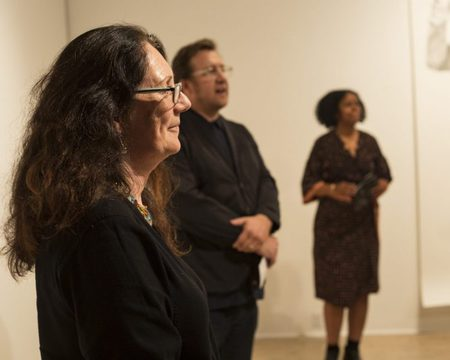
Curators Michelle Jacques, Doug Jarvis, and France Trépanier
at the Deconstructing Comfort exhibition opening reception
at Open Space during the PC/Cp Gathering 2017.
Photo credit: Kirk Schwartz.
The day after the Traditional is Contemporary is Traditional is… talk with Maikoiyo, someone mentioned that we should have our own podcast. It was a great talk. I’m having a hard time recalling it all to tell the truth. It was months ago.
The title Traditional is Contemporary is Traditional is… suggests, or fits well with, the indigenous dialogues about the nature of time. Two days after the talk Chris Creighton-Kelly said to me during the Sunrise Breakfast: “You must have contributed a wider view on time for your panel!” I replied that there was such a perspective in the panel but it didn’t originate with me.
Maikoiyo lead that part of the talk for sure. My impressions from that conversation was that he viewed time as expansive and non-linear. I don’t recall comprehending the whole of his explanation. At the same time I didn’t doubt his perspective at any moment.
In our discussion, I used the specific example of my pursuit of kayaking in relation to our question of time. I asked my Uncle Ron and Aunt Miriam as elders, if they remembered seeing kayakers growing up. Between them they had lived in the coastal Inuit communities of Okak, Nutak, Nain and Hopedale. Nothing. Not a single memory of the traditional hunting boat used during their lifetimes.
So Maikoiyo and I discussed what to make of this colonial wrinkle in time. The period when the kayak disappeared completely from its territory. Again, I can’t recall exactly how the non-linear part of this talk went—yet I was on board.
When I learned to do an “Eskimo Roll,” capsizing myself, being inverted underwater and then completing a full rotation with my body and paddle, I did so in an Inuit design with an Inuit technique. Sitting in the kayak back a top of the water, I completed something that my ancestors completed. The traditional has that power of connecting time in a way that does not take into account linear thinking.
Back in the panel, held in the windowless basement meeting room, the discussion opened up and I recall an active conversation. Then near the end of the session the discussion devolved and I could not follow along. It just got real flakey. “As a member of your tenure application panel could you expand on what you mean by ‘flakey’?” Ashok Mather pantomimed as a friend, exhorting me to always be respectful and mind my language. Two lessons I haven’t forgotten.
Thinking of the first conversation with Maikoiyo outside the Songhess Wellness Centre, we talked about of some amazing stuff. It was a free ranging discussion which also planned loosely for the panel ahead. At the end of the gathering we didn’t make any plans to have a podcast. Nothing like that. Just that it would be great to meet again in the future.
—Mark Igloliarte
.png)
Mark Igloliorte is an interdisciplinary artist of Inuit ancestry from Nunatsiavut, Labrador. His artistic work is primarily painting and drawing. In 2017, Igloliorte received a REVEAL Indigenous Art Award from the Hnatyshyn Foundation and to notelearned was also longlisted for a Sobey art award in 2012. He currently lives in Vancouver where he teaches at Emily Carr.